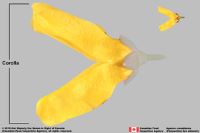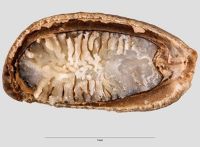Content is from Kirkbride et al. 2006Kirkbride et al. 2006:
Kirkbride JH, Jr, Gunn CR, and Dallwitz MJ. 2006. Family guide for fruits and seeds, vers. 1.0. Accessed September 2020-January 2022. URL: https://nt.ars-grin.gov/seedsfruits/keys/frsdfam/index.cfm ., without modification.
Updates are forthcoming.
Lauraceae A.J. Jussieu
Common name: Laurel Family.
Number of genera: 54 genera.
Number of species (Mabberley 1997): 2200 species.
 and mesocarpmesocarp:
and mesocarpmesocarp: absent and endocarpendocarp:
absent and endocarpendocarp: exposed.
exposed.
Fruits: Pistil(s) compound; 1; 1-pistillate; with carpels united. Fruit anthocarpanthocarp:
simple or compound and including some tissue of non-ovarian origin (accessory tissue) , or pericarpium; simple; drupedrupe:
, or pericarpium; simple; drupedrupe:
(indehiscent drupe) a fleshy, indehiscent fruit with one more hard pits enclosing seeds, derived from single, superior, simple or compound ovary; (dehiscent drupe) a fruit with a dry or fibrous to fleshy or leathery outer husk that early to tardily breaks apart (or opens), exposing one or more nutlike pits enclosing the seeds , or berryberry:
, or berryberry:
an indehiscent, fleshy fruit with one or a few to many seeds. The flesh may be homogenous throughout. Or, if the outer part is hard, firm, or leathery, referred to as an hesperidium. Septa are present in some, and the seeds may be arillate or with a fleshy testa. , or amphisarcum; berryberry:
, or amphisarcum; berryberry:
an indehiscent, fleshy fruit with one or a few to many seeds. The flesh may be homogenous throughout. Or, if the outer part is hard, firm, or leathery, referred to as an hesperidium. Septa are present in some, and the seeds may be arillate or with a fleshy testa. indehiscent; berryberry:
indehiscent; berryberry:
an indehiscent, fleshy fruit with one or a few to many seeds. The flesh may be homogenous throughout. Or, if the outer part is hard, firm, or leathery, referred to as an hesperidium. Septa are present in some, and the seeds may be arillate or with a fleshy testa. without central placental mass; simple, or schizocarpschizocarp:
without central placental mass; simple, or schizocarpschizocarp:
usually dry fruit splitting between two or more locules to form distinct, indehiscent, usually one seeded segments; fruit derived from a single, superior or inferior, compound ovary; compare to mericarp ; glans, or acrosarcum (Spjut using exactly the same words cited Crptocarya both here & in the rejected fruit type: pseudodrupe); pomarium (Spjut: 3 families: Lauraceae, Monimiaceae, Nelumbonaceae); without persistent central column; with styles(s); at apexapex:
; glans, or acrosarcum (Spjut using exactly the same words cited Crptocarya both here & in the rejected fruit type: pseudodrupe); pomarium (Spjut: 3 families: Lauraceae, Monimiaceae, Nelumbonaceae); without persistent central column; with styles(s); at apexapex:
the point farthest from the point of attachment, or the "tip" of an organ ; within accessory organ(s), or not within accessory organ(s); within perianthperianth:
; within accessory organ(s), or not within accessory organ(s); within perianthperianth:
collective term for calyx and corolla of a flower
 , or hypanthium, or corollacorolla:
, or hypanthium, or corollacorolla:
the inner whorl(s) of the perianth; all the petals of a flower , or cupule; accrescentaccrescent:
, or cupule; accrescentaccrescent:
growing continuously
; persistent; with hypanthium follicles; with hypanthium cupular; with hypanthium wall distinct from fruit wall; with hypanthium composed of 1 layer, or 2 layers; with hypanthium soft layer over hard layer; with hypanthium fleshy, or woodywoody:
texture—consisting mainly of indurate lignified tissues, characteristic of or resembling wood
; 1-seeded; 1-seeded; from 1–5 cm long; 1.4–1.5 cm long (to 7 cm in diameter); with 1-carpellate; not sulcatesulcate:
surface relief—having one or more elongate, relatively narrow and shallow depressions or grooves ; in transection tereteterete:
; in transection tereteterete:
approximately circular in cross section; width and thickness approximately equal
 ; apexapex:
; apexapex:
the point farthest from the point of attachment, or the "tip" of an organ not beaked; indehiscentindehiscent:
not beaked; indehiscentindehiscent:
not opening on its own, as in a fruit
 . Epicarpepicarp:
. Epicarpepicarp:
outer layer of fruit wall or pericarp, if divided into layers; note here used synonymously with exocarp black, or purple, or blue, or red; durable; crustaceouscrustaceous:
black, or purple, or blue, or red; durable; crustaceouscrustaceous:
texture—thin, dry, indurate, and brittle
; glabrousglabrous:
without hairs
; without armature; smooth; without wing(s); without apicalapical:
at or pertaining to the end of the seed or fruit distal from its point of attachment (i.e., base)
respiratory hole. Mesocarpmesocarp:
the middle layer of the pericarp, if divided into layers present; fleshy, or leatheryleathery:
present; fleshy, or leatheryleathery:
texture—moderately thick, tough, and very pliable
, or thin; composed of 1 unified layer; without lactiform cavity system; & endocarpendocarp:
the inner layer of the pericarp, if divided into layers sharply differentiated. Endocarpendocarp:
sharply differentiated. Endocarpendocarp:
the inner layer of the pericarp, if divided into layers present, or absent; not separating from exocarpexocarp:
present, or absent; not separating from exocarpexocarp:
outer layer of fruit wall or pericarp, if divided into layers; note here used synonymously with epicarp ; thin, or woodywoody:
; thin, or woodywoody:
texture—consisting mainly of indurate lignified tissues, characteristic of or resembling wood
; not splitting into 1-seeded pyrenes; without operculumoperculum:
a dehiscent cap (or lid) of a seed or fruit that opens during germination or dehiscence ; without secretory cavities; without longitudinallongitudinal:
; without secretory cavities; without longitudinallongitudinal:
of or relating to length or the lengthwise dimension
ridges. Funiculusfuniculus:
(alt. funicle) stalk connecting the ovule (later seed) to the ovary (later fruit) placenta short; short without seed bearing hookswith hooks:
short; short without seed bearing hookswith hooks:
bristles or spines with curved or backwards pointing tips, or with secondary bristles along their length (retinacula); not persisting in fruit after seed shed.
(retinacula); not persisting in fruit after seed shed.
Seeds: Arilaril:
(broad sense) appendicular structure that wholly or partly envelops a seed and is produced from or a modification of the funicle, raphe, or outer integument; usually fleshy or pulpy, sometimes spongy or tufted-capillate, often brightly colored absent. Seed larger than minute; 5 to less than 10 mm long to 10 to less than 25 mm long; 10–33(–60) mm long (in diameter); straight; in transection tereteterete:
absent. Seed larger than minute; 5 to less than 10 mm long to 10 to less than 25 mm long; 10–33(–60) mm long (in diameter); straight; in transection tereteterete:
approximately circular in cross section; width and thickness approximately equal
 ; not bowl shaped; not nutlike; without winglike beakbeak:
; not bowl shaped; not nutlike; without winglike beakbeak:
a usually firm, terminal appendage, sometimes tapered ; without caudatecaudate:
; without caudatecaudate:
tapering to a long, tail-like appendage appendage(s); at maturity without food reserves, or with food reserves; with endosperm; without canavanine. Sarcotestasarcotesta:
appendage(s); at maturity without food reserves, or with food reserves; with endosperm; without canavanine. Sarcotestasarcotesta:
pulpy or fleshy outer layer of the seed coat, simulates aril absent. Testatesta:
absent. Testatesta:
seed coat
 present; without markedly different marginalmarginal:
present; without markedly different marginalmarginal:
at, on, or close to the margin or border
tissue; without fleshy or leatheryleathery:
texture—moderately thick, tough, and very pliable
layer over hard layer; tight; without crease or line separating cotyledons from hypocotyl-radicle; without notch along margin where cotyledons from hypocotyl-radicle tip approach each other; without glands; without bristles; glabrousglabrous:
without hairs
; without wings; without collar; without operculumoperculum:
a dehiscent cap (or lid) of a seed or fruit that opens during germination or dehiscence ; colored; monochrome; thin, or thick; not becoming mucilaginousmucilaginous:
; colored; monochrome; thin, or thick; not becoming mucilaginousmucilaginous:
resembling mucilage; moist and sticky
when wetted; surrounding embryo. Endosperm development nuclear, or cellular (Cassytha). Embryo differentiated from food reserve; well developed; 1 per seed; completely filling testatesta:
seed coat
 (no food reserve); at one end of seed not extending into a depression or cup; foliatefoliate:
(no food reserve); at one end of seed not extending into a depression or cup; foliatefoliate:
appearing leaf-like
; with investinginvesting:
(of embryo) embryo is nearly or completely filling seed coat, straight, and axile and centric with spatulate cotyledons and covering the stalk for at least half its length; (of cotyledons) cotyledons spatulate and covering the stalk for at least half its length
cotyledons; straight; parallel to seed length; lying along one side of endosperm; with cotyledons abruptly connected to hypocotyl-radicle; without coleorhiza; without simmondsin; with cotyledons containing usually lauric acid, or oils, or starch; without stomata; not green; with 2 or more cotyledons. Cotyledons 2; well developed; 0.8–0.9 times length of embryo; somewhat to significantly wider than hypocotyl-radicle; 9 times wider than hypocotyl-radicle; entirely concealing hypocotyl-radicle; not foliaceous; massive, or thick; flat; smooth, or ruminateruminate:
testa or seed coat folded into the endosperm (sometimes); with apicesapex:
(sometimes); with apicesapex:
the point farthest from the point of attachment, or the "tip" of an organ laciniate; with margins separate; basally entire; equal in size; not punctatepunctate:
laciniate; with margins separate; basally entire; equal in size; not punctatepunctate:
surface relief—dotted with pits or with translucent, sunken glands or with colored dots, similar to pitted dotted. Hypocotyl-radicle small; straight; not thickened. Plumule occasionally evident.
dotted. Hypocotyl-radicle small; straight; not thickened. Plumule occasionally evident.
Literature specific to this family: Hyland, B.P.M. 1989. A revision of Lauraceae in Australia (excluding Cassytha). Austral. Syst. Bot. 2:135–343.
General references: Corner, E.J.H. 1976. The seeds of Dicots, esp. vol. 2. Cambridge University Press, New York, Cronquist, A. 1981. An integrated system of classification of flowering plants, 1,262 p. Columbia University Press, New York, Gaertner, J. 1788–1805. De fructibus et seminibus plantarum. The Author, Stuttgart, Goldberg, A. 1986 (dicots) & 1989 (monocots). Classification, evolution, and phylogeny of the familes of Dicotyledons. Smithsonian Contr. Bot. 58 for dicots (314 pp.) & 71 for monocots (74 pp.). [Goldberg's illustrations are reproduced from older publications and these should be consulted], Gunn, C.R., J.H. Wiersema, C.A. Ritchie, & J.H. Kirkbride, Jr. 1992 & amendments. Families and genera of Spermatophytes recognized by the Agricultural Research Service. Techn. Bull. U.S.D.A. 1796:1–500, Mabberley, D.J. 1987. The plant-book, 706 p. Cambridge University Press, Cambridge, Roosmalen, M.G.M. van. 1985. Fruits of the Guianan flora, 483 pp. Institute of Systematic Botany, Wageningen Agricultural University. Drukkerij Veenman B.V., Wageningen, Schopmeyer, C.S. 1974. Seeds of Woodywoody:
texture—consisting mainly of indurate lignified tissues, characteristic of or resembling wood
plants in the United States. Agric. Handb. 450:1–883, Spjut, R.W. 1994. A systematic treatment of fruit types. Mem. New York Bot. Gard. 70:1–182, and Wood, C.E., Jr. 1974. A student's atlas of flowering plants: Some dicotyledons of eastern North America, 120 pp. Harper & Row, New York.